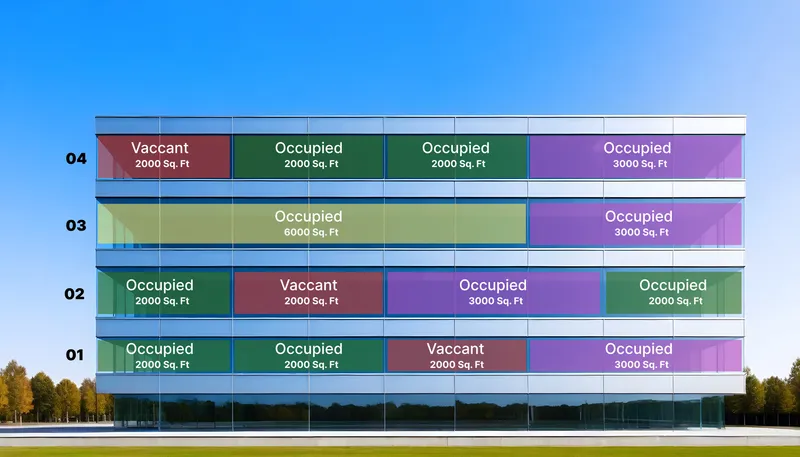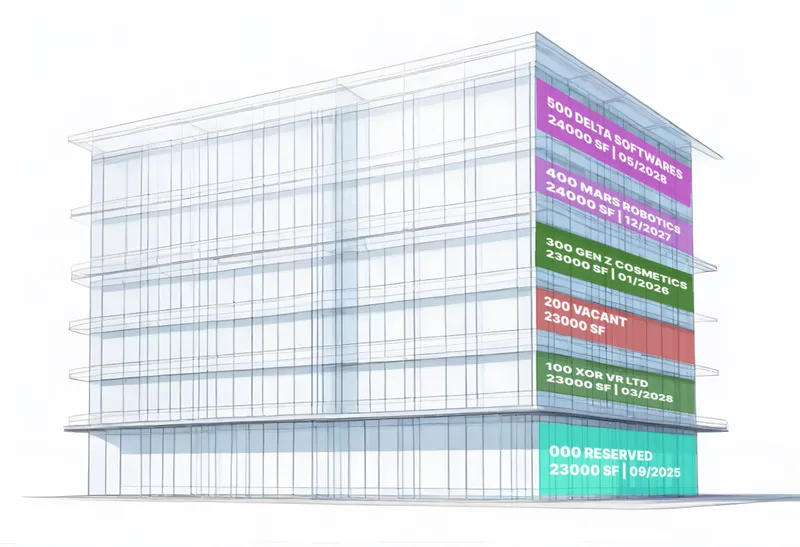
In today’s competitive business environment, optimising building occupancy is a critical aspect of real estate management that directly impacts revenue and operational efficiency. This blog explores the strategic use of stacking plans, an essential tool for property managers. These plans not only help in visualising tenant layouts and managing space efficiently but also in strategic decision-making to maximise building utilisation and profitability.

Effective occupancy management not only enhances profitability but also improves tenant satisfaction and retention. The financial stakes are significant, given that the global building efficiency market generated approximately $390.7 billion in 2022, marking a 7.6% increase from previous years.
Stacking plans are vital tools in real estate management that provide a visual representation of building occupancy. These plans outline which tenants occupy different spaces within a building, detailing aspects such as lease durations, square footage, and rent rates. This visual tool helps managers oversee and strategise the allocation of space more effectively, ensuring optimal use of the property's potential.

As buildings and their uses become increasingly complex, the role of stacking plans grows in importance. They serve not only as operational tools but also as strategic assets in property management. By effectively utilising stacking plans, building managers can anticipate and mitigate risks associated with vacancies and tenant turnovers, thereby enhancing the building's revenue potential and operational stability.
A stacking plan is a strategic tool used in commercial real estate to manage and visualise building occupancy. It presents a comprehensive diagram showing how space is distributed across the floors of a building, detailing tenant placements, lease terms, and space utilisation. This tool is crucial for property managers, owners, and investors as it aids in strategic decision-making and enhances the management of leases and space allocation.
Stacking plans are meticulously detailed to provide a clear overview of a building's occupancy and lease status. Here are the typical components included:

Through these components, stacking plans provide a critical strategic advantage by allowing property managers to optimise space, plan for future needs, and maintain high occupancy rates, thus maximising the profitability and operational efficiency of real estate assets.
Stacking plans are a strategic asset in real estate management, providing numerous benefits that enhance both operational efficiency and tenant relations.
Stacking plans are instrumental in maximising the use of space within a building. By providing a clear, visual layout of who occupies what space, and when their leases expire, these plans enable property managers to optimise space allocation and adjust as necessary to meet the dynamic needs of the building and its tenants. For instance, a stacking plan can help identify underutilised areas, allowing for strategic reallocation or redesign to better suit tenant needs or attract new lessees. This strategic deployment of space not only maximises the utility of the property but also can lead to significant cost savings and increased revenue by minimising vacant spaces and making efficient use of the available area.

Clear visualisation of tenant layouts and lease terms through stacking plans can significantly enhance tenant relationships. These plans provide tenants with a better understanding of their space and its context within the building, fostering a sense of clarity and transparency. Moreover, by having detailed information readily available, property managers can more effectively communicate with tenants regarding lease terms and negotiations. This open line of communication helps in resolving conflicts and ensures that both parties are on the same page, leading to higher tenant satisfaction and retention rates.
Stacking plans play a crucial role in risk management within property management. They enable property managers to proactively manage lease expirations and tenant turnovers, which are critical risks that can affect the financial stability of real estate investments. By visualising the expiration dates and current occupancy status, managers can strategise on lease renewals and re-letting processes well in advance, minimising the risk of income loss due to prolonged vacancies. Additionally, these plans can help identify potential discrepancies in lease agreements or tenant non-compliance with space usage policies, allowing for timely interventions.
Through the strategic use of stacking plans, property managers not only enhance operational efficiency and tenant relations but also bolster the overall risk management framework of their real estate portfolios. These benefits collectively contribute to maintaining and increasing the value of property assets in a competitive market.

Effective implementation of stacking plans involves regular updates to reflect the latest tenancy and market changes, ensuring the data remains relevant for decision-making.
To maintain the effectiveness of stacking plans, it is essential to update them regularly. This practice ensures that the plans accurately reflect current tenancy arrangements and are responsive to shifts in market conditions. Regular updates allow property managers to make informed decisions based on the most recent data, facilitating proactive management of spaces and leases. For instance, in the fast-evolving commercial real estate market, a property that does not regularly update its stacking plan may miss opportunities to optimise space usage or address vacancies efficiently.
The success of stacking plans heavily relies on the involvement of various stakeholders, including property managers, financial analysts, leasing agents, and sometimes tenants. Engaging these stakeholders throughout the stacking plan process ensures that the plans are comprehensive and consider all aspects of property management. For example, financial analysts can provide insights on the economic impact of lease arrangements and space usage, while property managers can align this with operational strategies (Stacking Plan Software). This collaborative approach not only enhances the relevance of the stacking plan but also ensures that strategic decisions are well-informed and supported by all relevant parties.

Effective implementation of stacking plans also depends on the proper training of staff and the adoption of these tools across the organisation. Training should cover the use of software and tools for creating and managing stacking plans, as well as strategies for analysing and interpreting the data these plans provide. Moreover, promoting widespread adoption of these tools within the organisation encourages a consistent approach to property management and ensures that all team members are equipped to use the stacking plans effectively. Adopting best practices in training can significantly enhance the operational efficiency and decision-making process within real estate management.
Incorporating these best practices into the implementation of stacking plans will maximise their strategic value, ensuring that they serve as effective management tools in the dynamic field of real estate.

Stacking plans are not just tools but strategic assets that transform real estate management into a precision-driven practice. By effectively utilising stacking plans, property managers can achieve optimal building occupancy, enhance tenant relationships, and implement robust risk management strategies. These plans empower stakeholders to visualise the current and future states of property occupancy, enabling proactive management that aligns with both market dynamics and tenant needs.
The benefits of stacking plans are manifold, from optimising space and boosting revenue to enhancing tenant satisfaction and safeguarding the property's value. Implementing best practices such as regular updates, stakeholder involvement, and comprehensive training ensures that stacking plans continue to serve as foundational elements in the strategic management of commercial real estate. By embracing these practices, property managers can ensure their assets are not only protected but also primed for growth in an ever-evolving market landscape.